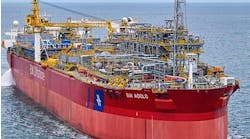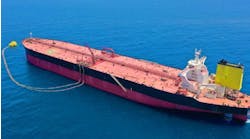New heavy-lift method saves money and time
Judy Maksoud
International Editor
Heavy-lift shipping company Jumbo has adapted standard technology to perform a combined transportation and install-ation project off Australia.
The Technip Coflexip-Subsea 7 joint venture (TCS7 JV) selected Jumbo to carry out a complex transportation and installation job for two primary reasons. First, and most importantly, Jumbo proposed to combine transportation and installation into a single operation using the same vessel, one of its twin 400-metric-ton lift capacity H-type heavy lift vessels (HLVs). Traditionally, transportation is separated from installation work and normally involves a ship or tug/barge combination for the transportation plus a floating crane for installation. Combining transportation and installation on a single platform offered important project economies.
The second reason was that working with two heavy cranes in tandem on one platform, the Jumbo HLV would offer much better cargo stability during the critical offshore installation phase, compared with a single crane installation. Lifting directly from its own deck rather than from a barge significantly improved the weather workability of the operation and minimized the chance of re-contact between the load and the deck.
The project
In April 2003, the TCS7 JV awarded Jumbo a contract for the transportation and installation of some of the subsea equipment required for Woodside's trunkline system expansion project offshore Dampier, Western Australia. The $553-million second trunkline project is an integral part of the North West Shelf Venture's gas production and liquefaction facilities, which includes constructing a fourth LNG processing train and associated infrastructure.
The $1.1-billion fourth train, which has a capacity of 4.2 million metric tons/yr of LNG, will boost North West Shelf LNG production to nearly 12 million metric tons per year. The second trunkline project is scheduled for completion in 1Q 2004 to coincide with completion of train 4. First LNG production from train 4 is scheduled for mid 2004.
null
The second trunkline will provide extra capacity to supply existing international and Western Australian customers, as well as prospective gas-related projects on the Burrup peninsula.
null
The six equal participants in the North West Shelf Venture are operator Woodside Energy Ltd., BHP Billiton Petroleum (North West Shelf) Pty. Ltd., BP Developments Australia Pty. Ltd., Chevron Australia Pty. Ltd., Japan Australia LNG (MIMI) Pty. Ltd., and Shell Development (Australia) Pty. Ltd.
The contract required Jumbo to install a 351-metric-ton valve skid, measuring 33.85 m by 16.2 m by 5.8 m, a 138-metric-ton subsea isolation valve skid, measuring 14 m by 10.18 m by 5.9 m, and various large diameter pipe spools measuring up to 59 m length and 36 m width, with weights of up to 111 metric tons.
Jumbo's scope of work included loading the equipment at the fabrication yard at Kwinana, near Henderson, Western Australia, transporting the items offshore to North Rankin 135 km northwest of Dampier, and overboarding and lowering the equipment to a depth of 110 m to effect hand-over to Technip's DP vessel CSO Venturer.
null
Adapting technology
Jumbo devised two critical adaptations for its heavy lift vessel that were essential for the operation. The first was a method to increase the ship's hook travel length, enabling it to work its cranes at the required depth of 110 m. The second adaptation involved the moment where the load becomes separated from the vessel during the lift. To optimize the stability of the load at that critical moment and maximize lift control, Jumbo designed a bumper guide grillage positioned on the HLV's deck that would guide the loads outboard during the lift. The same grillage would also be used for load spreading purposes and in sea fastening the load for the sea voyage.
An exhaustive simulation was carried out in the run-up to the actual operation. The motion analysis showed that the main limiting operational parameter would be a significant wave height of Hs (significant wave height) = 1.5 m, which tallied with the statistical weather data provided for the North Rankin offshore location at the time of year during which the lifts were to be undertaken.
The lift speed of the HLV's main blocks of 2 m/min combined with the vessel's low GM value (measure for initial stability) plus the extra damping factor of the submerged loads would limit the ship's roll and pitch to such an extent that heave compensating systems would not be necessary.
Finally, because the Jumbo HLV is not equipped with a dynamic positioning (DP) system, a three-point mooring system was developed involving the use of pre-installed mooring anchors, the HLV's own standard twin bow anchor system, and a supporting anchor handling tug (AHT).
Installation
By early August, Jumbo's MV Jumbo Vision was deployed to Singapore for the extra main hoist winches to be installed and the main hoist tackles to be re-reeved. The bumper guide grillage would be taken on board and pre-installed on the ship's deck in Australia.
On Aug. 28, MV Jumbo Vision arrived on schedule at the Tenix Yard at Henderson, Western Australia, for the load-out of the structures.
Three days later, having taken on the structures with its own gear and with its cargo lashed and secured in accordance with the detailed load-out procedure, MV Jumbo Vision sailed for the discharge location to rendezvous with the AHT and CSO Venturer.
Upon arrival on location, prevailing weather conditions were well beyond required operational parameters, and though the MV Jumbo Vision was positioned and moored, no further work was immediately possible.
When weather conditions improved and a sufficient weather window was predicted, work began again. The first structure, the 351-metric-ton valve skid, was lifted and smoothly released from its bumper guides. The skid was slewed slowly and brought parallel to the HLV's starboard side, all the while under the control of tugger lines to prevent undesired movement. With the load stabilized, the valve skid was lowered through the splash zone to begin its 100-m descent.
Meanwhile CSO Venturer had deployed one of its ROVs to monitor the descent and to prepare for the load transfer to the CSO Venturer's 400-metric-ton capacity linear winch. At the nominated depth, the ROV moved in to attach CSO Venturer's winch wire and release the MV Jumbo Vision's two hooks. When this operation was completed, the valve skid was moved on DP to the final installation location, then positioned and lowered onto the seabed. The following day, the same operation was repeated to install the SSIV skid.
All that remained after the second installation was to install the 30-in. diameter "U" shaped pipe spool and the 42-in. and 40-in. diameter "Z" shaped pipe spools.
The MV Jumbo Vision returned to Dampier to load the "U" spool on deck. Because of their awkward dimensions, the "Z" spools were loaded out from Dampier on a barge. Having discharged the "U" spool at site the MV Jumbo Vision returned to Dampier to re-reeve its main hoists in order to increase the lift speed for the discharge of the "Z" spools from the barge.
With the spool barge "hipped up" to the side of the HLV, the first "Z" spool was lowered to "wet storage" on the seabed on Sept 28. After some weather delay, the second "Z" spool was installed in a similar manner two days later.






